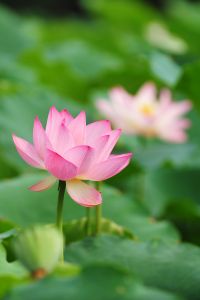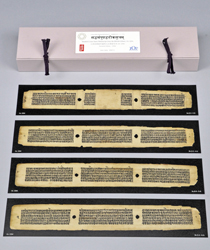 Mahayana Buddhism is composed of a body of writings developed from essential elements of the teachings of Shakymuni (the Buddha Gautama), which are wisdom and compassion. The Lotus Sutra, preached during the final years of Shakyamuni’s life, was in particular considered by Shakyamuni himself to be the quintessence of his teaching and its final result.
Mahayana Buddhism is composed of a body of writings developed from essential elements of the teachings of Shakymuni (the Buddha Gautama), which are wisdom and compassion. The Lotus Sutra, preached during the final years of Shakyamuni’s life, was in particular considered by Shakyamuni himself to be the quintessence of his teaching and its final result.
This very popular Buddhist text states that all human beings can attain Buddhahood. The original title in Sanskrit is Saddharmapundarika-sutra. Three Chinese translations of the Sanskrit text have reached us. Kumarajiva’s translation, held in high repute, is entitled “The Lotus Sutra of the Mystic Law.” In China and in Japan, when one refers to the Lotus Sutra, it is generally Kumarajiva’s translation of the year 406 CE that comes to mind. Nichiren often uses the words “Lotus Sutra” in his writings to designate Nam Myoho Renge Kyo, the Law that he defines as the essence of the Lotus Sutra.
According to Burton Watson, eminent professor of language and translator of the Lotus Sutra into English, “The Lotus Sutra is one of the most important and influential of all the sutras or sacred scriptures of Mahayana Buddhism, revered by almost all branches of the Mahayana teachings, and over many centuries the object of intense veneration among Buddhist believers throughout China, Korea, Japan, and other regions of eastern Asia.” (The Lotus Sutra, Columbia University Press, 1993, p. ix)
The Lotus Sutra reveals Shakyamuni’s vow, formulated in the distant past, to elevate the life state of all human beings to make them equal to himself, and shows that this vow was fulfilled when he preached this sutra. The Lotus Sutra constantly encourages compassionate action in order to keep alive this eternal vow of Shakyamuni.
The SGI president, Daisaku Ikeda, expresses the following about the Lotus Sutra in his foreword to the French version of The Writings of Nichiren Daishonin:
“According to the Lotus Sutra, quintessence of Mahayana Buddhism, the innate fundamental desire of all human beings (…) corresponds precisely to the great bodhisattva vow: simultaneously to attain one’s personal happiness and to permit others to do the same. To awaken others to this desire is to allow them to enter into contact with the goodness inherent in their life, which constitutes the fundamental mission not only of Buddhism, but of all religions.”
 The Lotus Sutra also affirms that enlightenment is potentially open to all, without distinction based on race, gender, social status, or education. Consequently, it is a humanistic teaching that affirms the sacred quality of life.
The Lotus Sutra also affirms that enlightenment is potentially open to all, without distinction based on race, gender, social status, or education. Consequently, it is a humanistic teaching that affirms the sacred quality of life.
The Lotus Sutra comprises 28 chapters combining passages in prose and in verse. Every day, in addition to chanting Nam Myoho Renge Kyo, SGI practitioners recite extracts from two chapters of the Lotus Sutra: the Hoben chapter (also known as the chapter “Expedient Means”), and the Juryo chapter (also known as the chapter “The Life Span of the Thus Come One”).